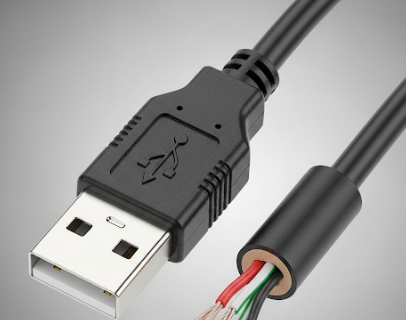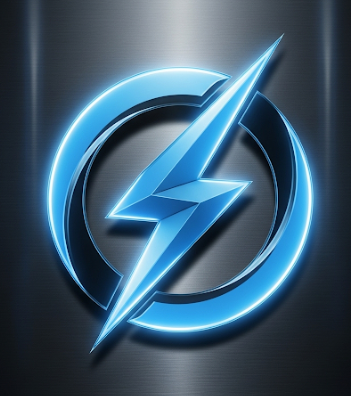How to Identify Different USB Types
Before you connect a USB cable, take a moment to look at the plug itself. A blue piece of plastic inside or a tiny symbol like 'SS 10' isn't just for decoration—it can mean the difference between a file transferring in seconds or minutes.
The most crucial concept to understand is that a connector's physical shape, especially the modern oval USB-C, is separate from its performance. That shape doesn't guarantee speed or charging power. This guide will show you how to read these visual clues—the shape, color, and symbols—to know exactly what your cable and port can do.
How to Identify USB Types by Their Shape
The easiest way to identify a USB cable is by the shape of its plug. As technology demanded more speed and power, different plug designs were created, which is why we have so many types today.
USB Type-C: The Reversible Oval Connector
The USB Type-C connector is the modern standard for new devices. Its most recognizable feature is its small, thin, symmetrical oval shape. This design makes it reversible, so you can plug it in correctly without looking. You will find the Type-C port on most modern electronics, including the iPhone 16 series, recent Android smartphones, high-performance laptops, tablets, and gaming peripherals.
It's important to remember, however, that the Type-C connector is just a shape. Its actual capabilities—how fast it charges, transfers data, or sends video to a monitor—are determined by the protocol it supports. A Type-C port can use a slow USB 2.0 protocol or support the very high speeds of Thunderbolt 4. The shape itself does not guarantee performance.
USB Type-A: The Rectangular "Host" Plug
For many years, USB Type-A was the most common plug for computers and chargers. Its flat, wide, rectangular form is familiar to most people. Unlike Type-C, it is not reversible and has to be oriented correctly to plug in. This connector is mostly found on the "host" end of cables, which plugs into devices like computers, wall chargers, or power stations that supply power or data.
While the shape is consistent, the plastic insert inside the plug provides clues about its speed:
A white or black insert typically means it uses the older, slower USB 1.1 or USB 2.0 standards.
A blue insert is the most common indicator for the faster SuperSpeed USB 3.x. A close look reveals nine internal pins instead of the four found in USB 2.0.
Teal, red, or yellow inserts usually indicate even higher performance USB 3.1/3.2 ports or special "always-on" charging ports that work even when the computer is asleep.


The USB Type-B Family: For Printers, Hard Drives, and Older Devices
Before USB-C became common, a family of "Type-B" connectors was used to connect various devices to a computer.
Standard Type-B (USB 2.0): This connector has a square-like shape with sloped top corners. It's still found on larger devices like printers, scanners, and audio equipment.
Mini-USB (Mini-B): Now largely obsolete, this small, 5-pin trapezoidal connector was one of the first smaller plugs, used for older digital cameras, MP3 players, and early smartphones before being replaced.
Micro-USB (Micro-B): For over a decade, Micro-USB was the main connector for portable electronics. It's a thin, 5-pin trapezoidal plug that's still common on budget-friendly smartphones, power banks, e-readers, and many other small gadgets.
USB 3.0 Type-B: This connector looks like a standard Type-B but is taller, with an extra section on top for more pins. It was designed to bring faster speeds to equipment like docking stations and professional-grade printers.
USB 3.0 Micro-B: This wide plug looks like a Micro-USB with a second, smaller connector attached to its side. It was used almost exclusively for portable external hard drives and SSDs that required faster transfer speeds.
These physical shapes are the most obvious feature of any USB connector. While they tell you which devices the cable can plug into, they don't reveal its full performance, which requires looking at the technical details that define its actual speed and function.
How to Identify the USB Standard by Speed and Logos
Once you've identified the physical shape of the connector, the next step is to determine the protocol it uses. The protocol defines the speed of data transfer, the power it can deliver, and any additional features it might support.
The Naming Scheme
The organization responsible for the standard, the USB Implementers Forum (USB-IF), has renamed the standards multiple times, creating significant confusion. Here is a clear translation of the USB 3.x and USB4 naming conventions:
5 Gbps: What was originally called USB 3.0 became USB 3.1 Gen 1, and is now officially known as USB 3.2 Gen 1.
10 Gbps: Originally USB 3.1, this was renamed to USB 3.1 Gen 2 and is now called USB 3.2 Gen 2.
20 Gbps: This is known as USB 3.2 Gen 2x2. It requires a USB-C connector on both ends of the cable to function.
The Generations of Data Speed
The logos printed next to a port are the most reliable indicators of its speed.
Legacy Speeds:
Before 2008, USB 1.1 offered up to 12 Mbps, while USB 2.0 (Hi-Speed) pushed this to 480 Mbps. These ports are typically marked with the standard black-and-white trident logo (⎌).
The SuperSpeed Era (USB 3.x):
This generation introduced significantly faster data rates, crucial for transferring large files. The logos reflect these speeds:
- USB 3.2 Gen 1 (5 Gbps): The logo is a trident with an "SS" (for SuperSpeed).
- USB 3.2 Gen 2 (10 Gbps): The logo adds the number "10" to the SuperSpeed symbol.
- USB 3.2 Gen 2x2 (20 Gbps): This logo includes the number "20".
The Modern Era (USB4):
Based on the high-performance Thunderbolt 3 protocol, USB4 represents another leap in capability. It uses the USB-C connector exclusively.
- USB4 Gen 2x2 (20 Gbps): The logo is a trident with a "20".
- USB4 Gen 3x2 (40 Gbps): The logo is a trident accompanied by the number "40". This level of bandwidth is essential for demanding tasks like competitive gaming on high-refresh-rate monitors or connecting multiple 4K displays.
Thunderbolt
Thunderbolt is a separate protocol developed by Intel that also uses the USB-C connector shape. It is always identified by a lightning bolt (⚡) symbol next to the port. For users who need maximum performance, such as competitive gamers requiring the fastest response times from peripherals and displays, a Thunderbolt port is the gold standard.
- Thunderbolt 3: Offers a blistering 40 Gbps of bandwidth and laid the foundation for the USB4 standard.
- Thunderbolt 4: Also provides 40 Gbps but enforces stricter requirements than USB4, such as mandatory support for two 4K displays.
- Thunderbolt 5: The newest iteration, pushing speeds to 80 Gbps, further solidifying its position as the pinnacle of wired connectivity.
A port's name and logo tell you its data transfer standard, from basic USB 2.0 to high-performance Thunderbolt. But speed is only part of the story; some ports offer advanced charging and video features that go beyond the basic USB specification.


How to Identify USB-C Port Types: From "Data-Only" to "Full-Function"
A USB-C port's capabilities often go beyond simple data transfer. Many can also handle high-power charging and direct video output, effectively replacing other ports. Here’s how to identify these powerful features.
Power Delivery (PD): For Laptop Charging
USB Power Delivery (PD) is a standard that allows a USB-C cable to deliver enough power (up to 240W) to charge large devices, including high-performance laptops. This is the feature that lets you use a single USB-C cable for both data and power, eliminating the need for a traditional barrel-style power adapter.
How to Identify:
There is no universal logo for PD. The only reliable way to confirm it is to check the technical specifications of your device or charger. Look for a specific wattage output, such as 65W, 100W, or 140W. Manufacturers will almost always advertise this feature.
Video Output (Alternate Modes): For Connecting to Displays
"Alternate Mode" allows a USB-C port to send video signals, letting it function as a direct replacement for an HDMI or DisplayPort connection.
Look for symbols printed next to the USB-C port itself:
- A DisplayPort logo (a "D" inside a "P") or a simple "DP" means it supports DisplayPort Alt Mode. This is crucial for connecting to many high-resolution and high-refresh-rate monitors.
- A lightning bolt symbol (⚡) indicates a Thunderbolt port. All Thunderbolt ports (versions 3, 4, and 5) are required to support DisplayPort video output.
- A USB4 logo also guarantees support for DisplayPort video output.
Knowing how to spot these features is essential for getting the most out of your hardware, especially when connecting to docking stations or multiple displays.
Verify Your USB Types for Full Performance!
Identifying any USB port comes down to a simple process: check the shape, look for logos to determine its speed, and for USB-C, verify its charging and video capabilities. Applying this knowledge is key, especially for high-performance equipment. It ensures your gaming monitor gets the full refresh rate and your peripherals have the fastest connection, letting you focus on the competition. If your devices require different charging ports, the EcoFlow RAPID 65W GaN Charger is the perfect solution. With its 2 × USB-C and 1 × USB-A ports, you can power up to three devices simultaneously—all while enjoying the convenience of the included 100W cable for fast, efficient charging.
FAQs about USB Types
Q1: Do I need a special cable for faster speeds like USB4 or Thunderbolt?
Yes, the cable is just as important as the port. To get the fastest speeds from a high-performance port like USB4 or Thunderbolt, you need a cable that was built for it. If you use an old or lower-quality cable with a super-fast port, the cable becomes the weak link and will slow everything down. For the absolute best performance, especially at 20Gbps or 40Gbps, use a high-quality cable that specifically says it supports those speeds.
Q2: Can I plug an older USB device into a newer port, or vice versa?
Yes, you can mix and match. The USB standard is designed so that new and old devices still work together. For example, your old mouse will work perfectly fine when plugged into a brand-new, high-speed port. The only thing to remember is that the connection will always run at the speed of the slowest part. So, if you plug a new, fast hard drive into an old, slow port, it will work, but your file transfers will be slow.
Q3: Why won't my laptop's USB-C port connect to my monitor?
This is a common problem, and it's usually because that specific USB-C port on your laptop doesn't support sending a video signal. Even though the plug fits, not all USB-C ports are built to handle a display connection. To check if yours can, look for a small symbol right next to the port. If you see a DisplayPort logo (DP) or a lightning bolt (⚡ for Thunderbolt), you're good to go. If you don't see one of those symbols, that port is likely just for data or charging.